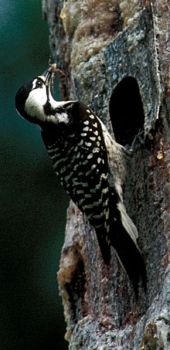Red-cockaded Woodpecker (Dryobates borealis)
- Texas Status
- Endangered
- U.S. Status
- Threatened, Listed 11/25/2024
- Description
- Red-cockaded woodpeckers are 8.5 inches long.
- Life History
- Red-cockaded woodpeckers sleep (roost) and nest in cavities (holes) in live pine trees. Cavities are built only in large, old pines. These woodpeckers live in family groups which may include the male and female, their chicks, and young adult "helpers." These "helpers," typically related male young from previous nesting seasons, help build cavities, defend the territory, and assist in incubating the eggs and feeding the chicks. Pecking a cavity in a live tree takes a long time, since the wood is very hard. After completing a cavity, the birds peck through the bark around the entrance to get the sap (resin) flowing around, to the side, and below the cavity entrance. The sticky sap keeps predators like rat snakes away from the nest cavity. They eat insects and other invertebrates found under the bark and along the branches of pine trees; some foraging (searching for food) can also occur on hardwood trees. A small part of their diet can also consist of fruits, berries, and seeds. Females lay 2 to 5 eggs in the male's cavity during breeding season. A woodpecker group roosts and nests in a cluster of 1 or more cavity trees. Most clusters have some cavities under construction, some completed and in use, and some previously used but currently abandoned.
- Habitat
- Open pine forests with large, widely-spaced older trees provide essential habitat for the red-cockaded woodpecker.
- Distribution
- The red-cockaded woodpecker can be found in the Pineywoods of East Texas.
- Other
- Red-cockaded woodpeckers were initially listed as endangered in 1970 because the open forests with large, old pine trees have been replaced by forests with younger, smaller pines. Also, periodic natural fires, which historically kept the pineywoods open, have been suppressed since settlement. Periodic fire is needed to control the brushy understory and keep the pinewoods open. However, after a 5-year review of the best available scientific information, U.S. Fish and Wildlife Service has reclassified this woodpecker as threatened. The species' population numbers have improved such that it is not currently in danger of extinction and does not fit the definition of "endangered" anymore. In 2024, it was estimated around 1,500 red-cockaded woodpeckers lived in Texas.
